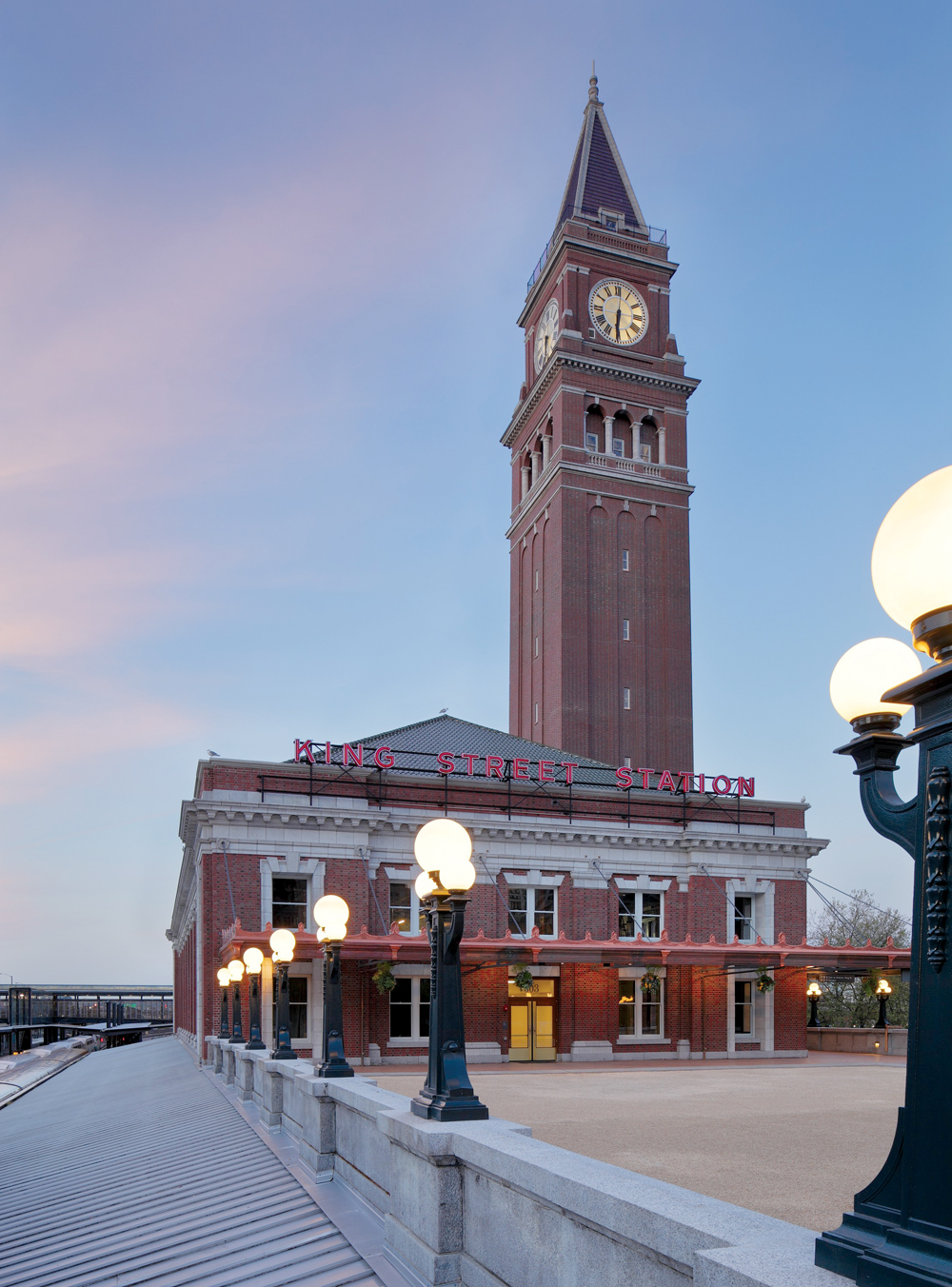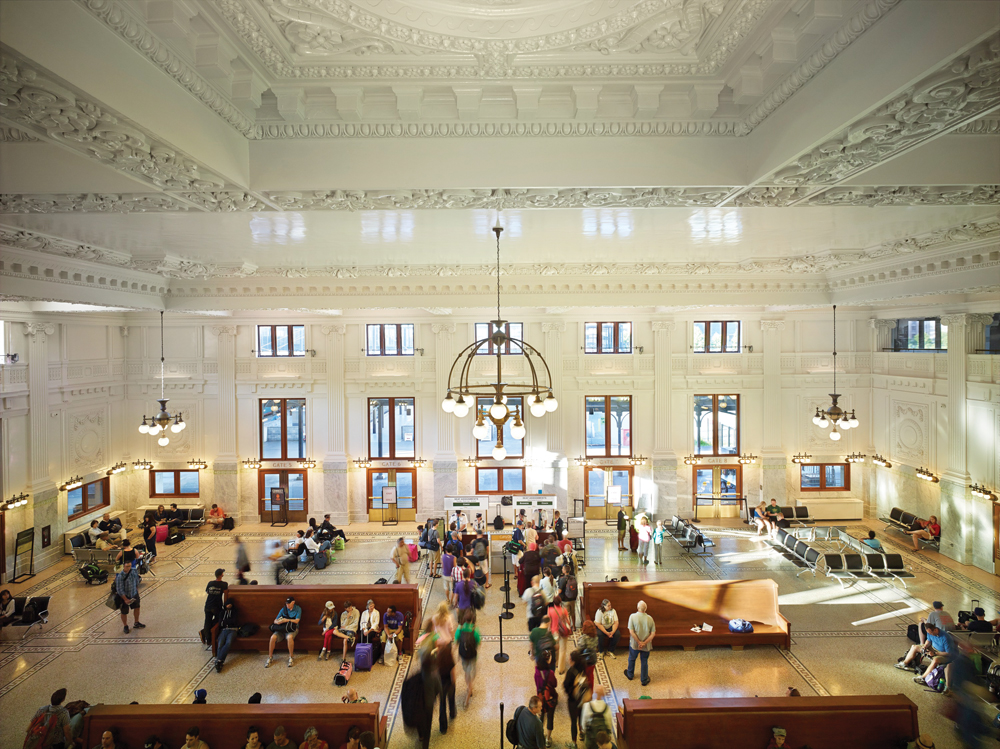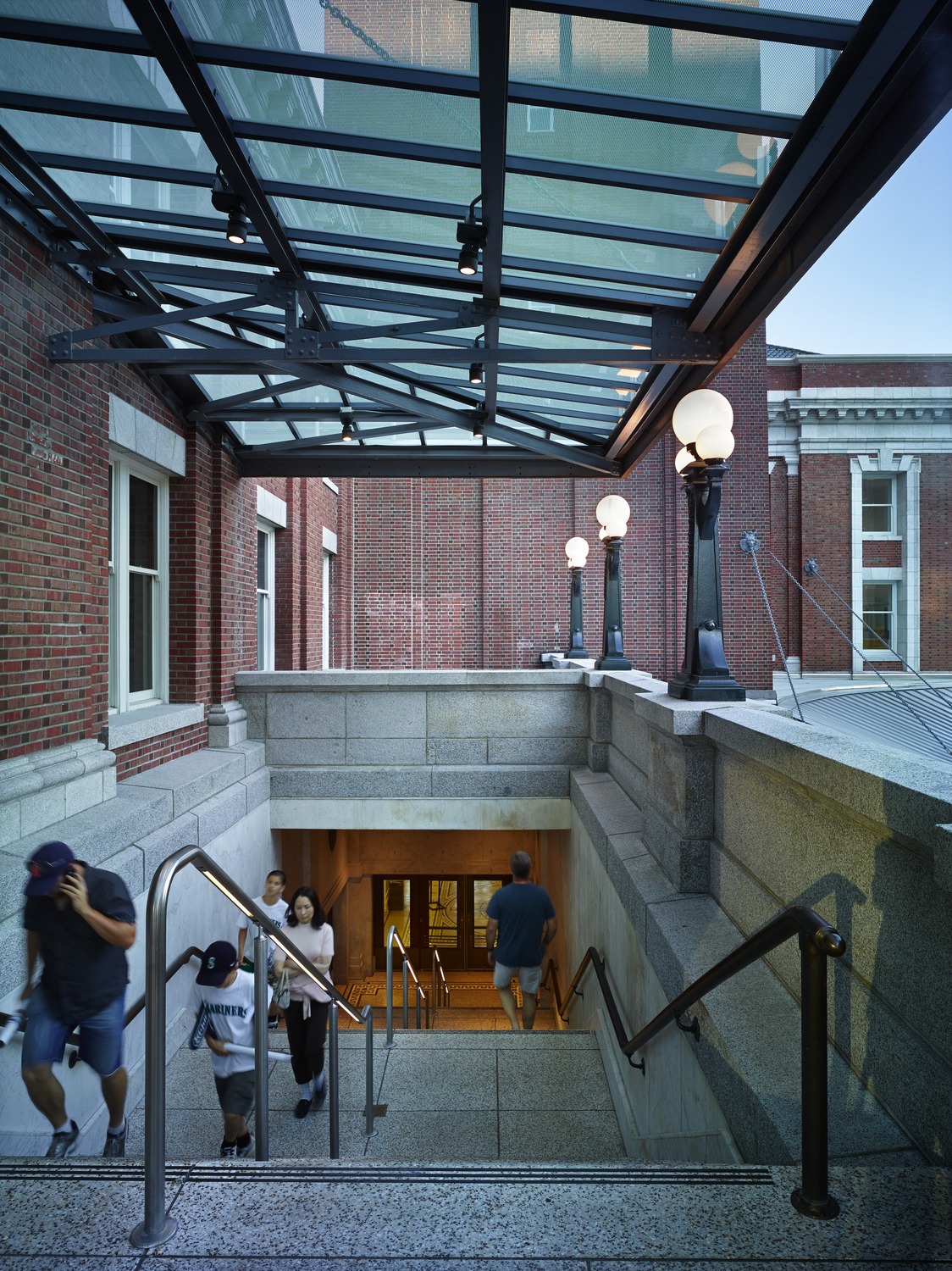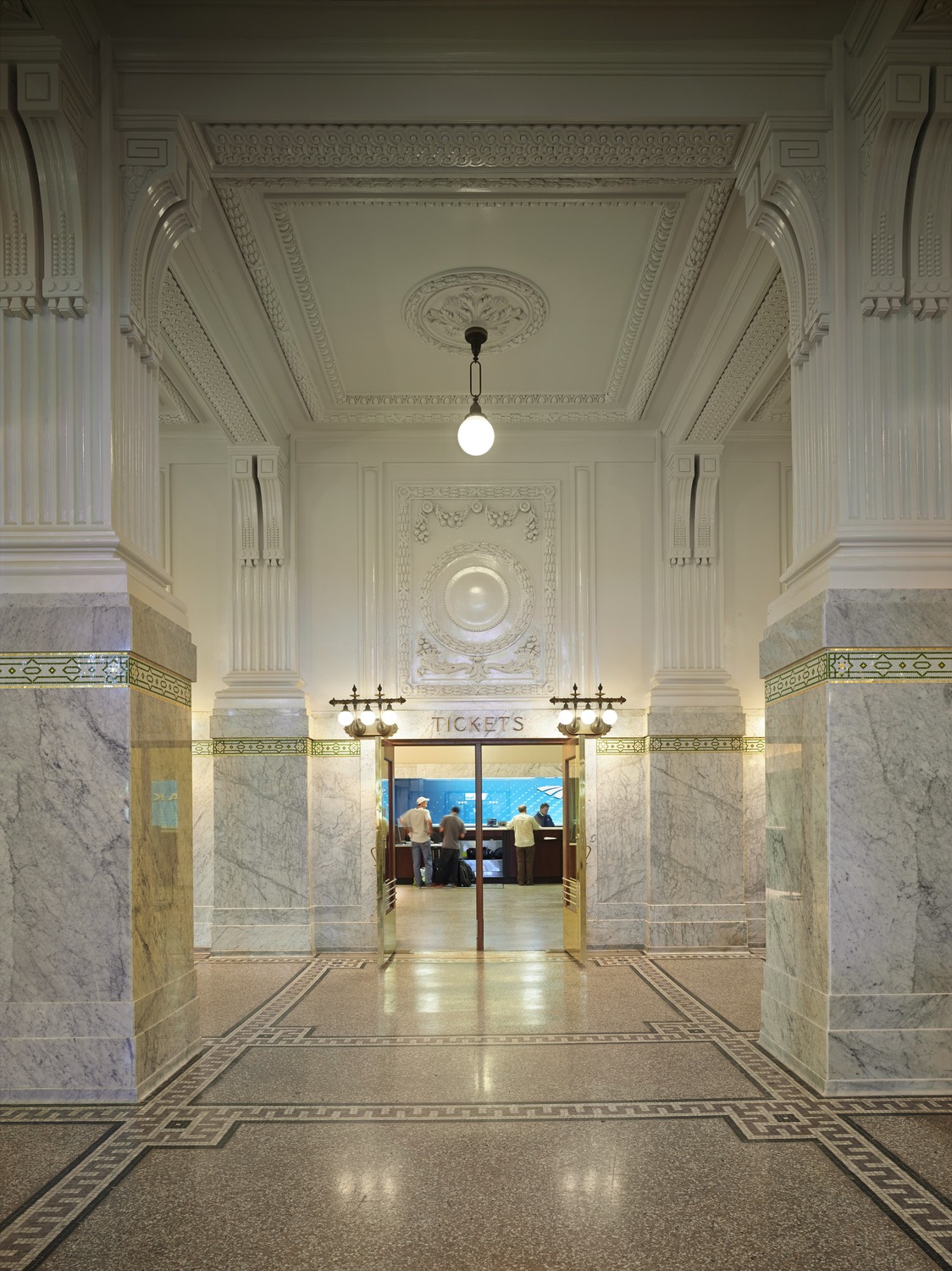When Seattle’s King Street Station opened its doors in 1906, it stood as a bold symbol of the city’s newfound prominence as the region’s primary shipping port—a position the Emerald City holds to this day.
Designed by architects Charles A. Reed (1858-1911) and Allen H. Stem (1856-1931), most noted for their work on New York’s Grand Central Terminal, King Street Station was the centerpiece of a massive enterprise that shifted the city’s main rail lines from the waterfront to the central business district, thanks to the construction of a 5,245-foot tunnel beneath the city. The L-shaped, 62,400-sf terminus quickly became the busiest train station in the Northwest, earning it the nickname “Gateway to the West.”
The Italianate depot features a distinctive, 242-foot-tall clock tower, the second-tallest such structure on the West Coast; it was modeled after the Campanile di San Marco in Venice. At the time of its completion, the station was the tallest structure in Seattle. Inside, bright-white plaster and marble decorated the walls and ceiling of the waiting areas.
The depot was placed on the National Register of Historic Places in 1973, but by that time it had lost much of its grandeur. Poorly conceived modernizations in the ’40s, ’50s, and ’60s led to the removal of large sections of the plaster and marble walls and glass mosaic tile accents. The magnificent plaster ceiling was covered with acoustical tiles. The roof was crumbling. The staircase on Jackson Street was boarded up. The four tower clocks were right only twice a day.
PLATINUM AWARD WINNER
King Street Station
SeattleBuilding Team
Submitting firm: ZGF Architects (architect)
Owner: Seattle Department of Transportation
Structural/MEP engineer: Arup
Construction manager: Shiels Obletz Johnsen
General contractor: Sellen ConstructionGeneral Information
Construction time: Sept. 2009 to April 2013
Size: 62,400 sf
Delivery method: CM at risk
Cost: $55 million
The demise of train travel in the mid-20th century, coupled with a falloff in funding for maintenance, saw the station fall even further into a state of disrepair. Most urgently in need of shoring up were the unreinforced masonry walls—inspections showed that the structure was in no shape to withstand a major seismic event.
As rail ridership began to pick up in the 2000s, the city of Seattle decided it was time to upgrade and restore its landmark rail station. In February 2008, the city purchased the building from the Burlington Northern Railway Company for $10 and then went about rounding up the $55 million needed for a complete rehab and modernization (60% of funding came from federal sources; the balance was split between state and local sources).
The project scope encompassed full seismic retrofit and structural upgrade work, rehabilitation of the clock tower, full MEP/FP upgrades, and repair and restoration of the 45-foot-high ornamental plaster ceilings and walls, the terrazzo and mosaic tile floors, and the operable windows—all while striving for LEED Platinum certification. Complicating matters was a requirement from the city that the station remain fully operational during the project—a goal the team achieved by dividing the work into multiple phases.
INSERTING A NEW STRUCTURE
Half the budget was allocated for the structural repair and seismic retrofit work—a tedious, meticulous process that involved inserting a new steel frame structure inside the existing masonry walls with surgical precision so as not to disturb the historical elements. The Building Team cut 35-foot-high slots into the brick perimeter and inserted steel columns and high-strength grout alongside the existing columns.
New shear walls were created for the 8,000-sf waiting room. Steel floor plates were added on levels two and three for additional strengthening. The 12-story clock tower was cross-braced; new columns were added on all four corners. A total 1,345 tons of steel was installed to support the interior spaces.

A system of geothermal wells was bored underneath the downtown plaza; it is designed to cover 100% of the 62,400-sf building’s heating and cooling needs. The clock tower rises 242 feet to its peak. ZGF Architects led the Building Team for the client, the Seattle Department of Transportation. Photo: Benjamin Benschneider Photography
While not as costly as the structural work, the rehabilitation of the historic interior elements was no less difficult. To replicate damaged and missing elements of the ornamental plaster walls and ceiling, matching molds were painstakingly created using the original ornate pieces and the same casting methods craftsmen employed more than a century ago. The molds were filled with casting plaster and inlaid with hemp and burlap during the casting process to create the final pieces. The castings were then stripped out of the molds, reinstalled, and attached to the structure.
The Building Team removed all of the sashes and trims from the original windows and refinished and reinstalled them using all remaining original glass. In all, the team restored 74 window openings and 199 sashes and replicated 15 window openings and 33 new sashes.
Significant care was taken to protect the floors during the structural steel installation and helical pile drilling. Areas of the marble inlaid terrazzo floors were catalogued, removed, and reinstalled after the new buried structure was installed. Where the original tile flooring was missing, the team repurposed existing pieces of marble to replicate the floor elements.
In honoring King Street Station with a Platinum Award, the Reconstruction Awards jury commended the Building Team on its technical precision in executing both heavy construction work—structural steel reinforcing and geothermal installation—and extremely delicate and often tedious historic restoration work—all while the station remained operational.
“The fact that they were able to execute all of this work while achieving LEED Platinum certification through features like geothermal makes the project even more impressive,” said judge Krista Gnatt, LEED AP, Preconstruction and Business Development Manager with Bulley & Andrews, Chicago.
Related Stories
| Aug 11, 2010
Walt Disney Family Museum planned in San Francisco
Construction is under way on a new museum dedicated to the man behind the Disney empire. Set to open this fall in San Francisco, the Walt Disney Family Museum will feature 10 galleries, starting with Disney's beginnings on a Missouri farm.
| Aug 11, 2010
SAFTI FIRST hires Tim Nass as National Sales Manager
SAFTI FIRST, a leading USA manufacturer of fire rated glazing and framing systems, is pleased to announce the addition of Tim Nass as National Sales Manager. In his new role, Tim will be working closely with architects and contract glaziers in selecting the appropriate and most economical fire rated glazing solution for their project. He will also be coordinating SAFTI FIRST’s extensive network of architectural representatives throughout the United States.
| Aug 11, 2010
NCARB welcomes new board of directors
The National Council of Architectural Registration Boards (NCARB) introduces its Board of Directors for FY10, who were installed during the culmination of the Council’s 90th Annual Meeting and Conference in Chicago.
| Aug 11, 2010
Berkebile wins $100K award for commitment to environment
Robert Berkebile, the founding principal of BNIM Architects and a founding member of the U.S. Green Building Council, has been selected to receive a $100,000 Heinz Award. The award honors his role in promoting green building design and for his commitment and action toward restoring social, economic, and environmental vitality to America’s communities through sustainable architecture and planning.
| Aug 11, 2010
Polshek Partnership unveils design for University of North Texas business building
New York-based architect Polshek Partnership today unveiled its design scheme for the $70 million Business Leadership Building at the University of North Texas in Denton. Designed to provide UNT’s 5,400-plus business majors the highest level of academic instruction and professional training, the 180,000-sf facility will include an open atrium, an internet café, and numerous study and tutoring rooms—all designed to help develop a spirit of collaboration and team-oriented focus.
| Aug 11, 2010
University of Florida aiming for nation’s first LEED Platinum parking garage
If all goes as planned, the University of Florida’s new $20 million Southwest Parking Garage Complex in Gainesville will soon become the first parking facility in the country to earn LEED Platinum status. Designed by the Boca Raton office of PGAL to meet criteria for the highest LEED certification category, the garage complex includes a six-level, 313,000-sf parking garage (927 spaces) and an attached, 10,000-sf, two-story transportation and parking services office building.
| Aug 11, 2010
Draft NIST report on Cowboys practice facility collapse released for public comment
A fabric-covered, steel frame practice facility owned by the National Football League’s Dallas Cowboys collapsed under wind loads significantly less than those required under applicable design standards, according to a report released today for public comment by the Commerce Department's National Institute of Standards and Technology (NIST).










